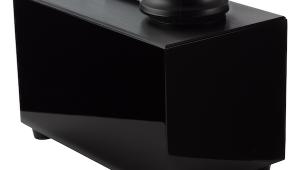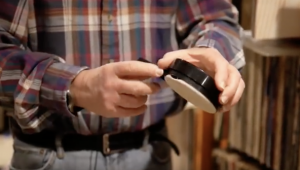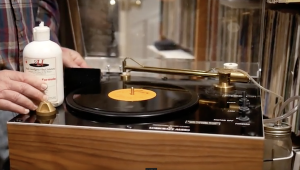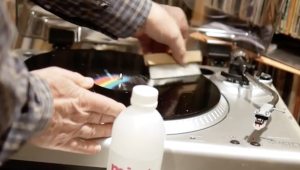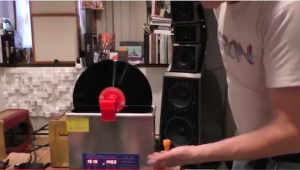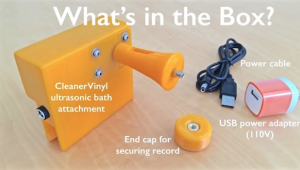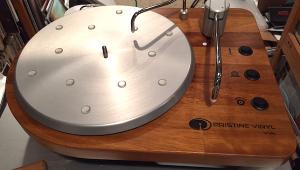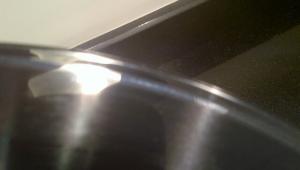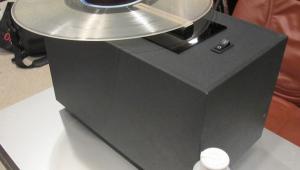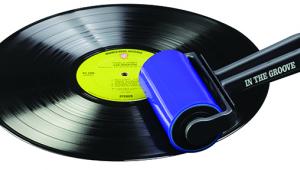Nitty Gritty’s Compact $839 Model 1.5 RCM, Despite Shortcomings, Does Its Job Well

Overview
The Model 1.5 retails at $839 for a 110-120v unit ($100 retail more for a 220 volt unit, although Elusive Disc, whose Kevin Berg recently revived Nitty Gritty, sells the 220v for $855). It features Nitty Gritty’s Capstan Record Drive that rotates the record’s edge, a set of microfiber pads that apply the cleaning fluid to the record, a vacuum between the pads that removes the fluid along with any remaining dirt, a platter that contacts only the label area (meaning it doesn’t contaminate your newly cleaned record), and an exterior made of MDF and plastic. Viewed from the front, a switch pressed forward spins the record, and adds the vacuum when pressed backward (center position is “off”). The RCM is quite compact, measuring roughly 9x15x8.5”, and also has a compartment for the supplied liquid, a 4oz bottle of Nitty Gritty’s 90% distilled water, 10% alcohol (what kind, we don’t know) Pure 2. There’s a slot underneath the machine for catching the vacuumed fluid, but most of the time the fluid inside the hot machine instead evaporates.
The Model 1.5 In Action
A few months before receiving the Nitty Gritty machine, I tried the VinylStyl manual record washer, which much like the more popular SpinClean, washes records in a bath of liquid after which you place them on a drying rack (essentially, treating records like dishes). While the VinylStyl quiets records’ surfaces, it leaves on them a residue that attracts VinylStyl’s poly inner sleeves, and during playback, the residue adheres to the stylus.
In contrast, the Model 1.5 rarely leaves any mark on your records, and when it does it’s barely noticeable. To operate the machine, you pour fluid on the microfiber pads, for 2-3 rotations let them brush the record, and then vacuum up the liquid for 3-5 rotations (at a slower than 33rpm speed and counterclockwise). All of the records I cleaned on the 1.5 quieted down as best they could given their condition (and considering that the Nitty Gritty is a cleaning, not a “restoration” machine), which oftentimes resulted in very quiet records. Really, there’s not that much else to say aside from that it cleans records better than will any manual cleaning method will.
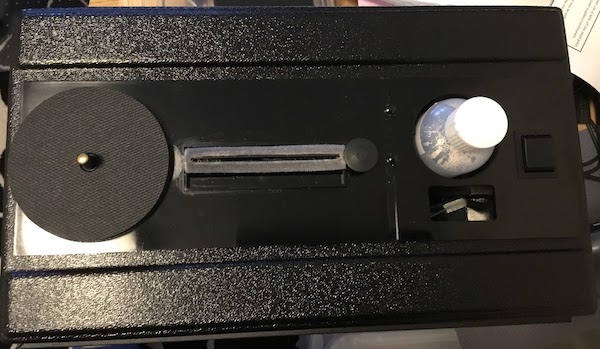
However, there are a few downsides. As expected from vacuum RCM’s, the vacuum is very loud, which I sometimes find stress-inducing (and I’m not easily stressed by sound). The rubber feet marking up the surface it’s placed on is only a minor annoyance, but worse is that, as the edge motor only works on 12” LPs, 10”’s and 7”’s have to be manually spun. Sure, LPs make up the vast majority of my collection, but this is an obvious oversight in the Model 1.5’s design that, in comparison to other RCM’s, might for some, be a deal breaker. Lastly, it warms up very quickly, meaning that you can only clean a few records at a time before your room begins to smell like record cleaning fluid (ah, the sweet, wonderful smell of cleaning alcohol and distilled water!). Still, machines that alleviate these issues take up several times more space than the Nitty Gritty, and if your room effectively absorbs sound, the machine’s loudness wil be less of an issue (my listening room is a “reverby” space without acoustic treatment—but I listen “near-field” so it’s not an issue).
Conclusion
Overall, the Nitty Gritty Model 1.5 is a compact vacuum record cleaner that, despite several design oversights, cleans LPs just about as well as other machines in its price range (while I’ve never had another vacuum RCM at home, I occasionally used my favorite NJ record store’s VPI 16.5). The small-platter design keeps records dirt-free, and the 1.5’s convenient size is great for those living in small spaces (or big houses completely consumed by records). Even though it’s not the most budget-minded RCM, if you’re looking to go all-out on a holiday present (whether that be for a friend, family member, or yourself), the Model 1.5 might be worth considering.
